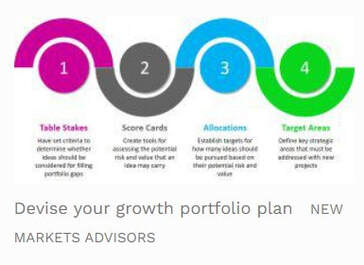|
If you’re tasked with finding new ways for a company to grow, your challenge is likely not a dearth of ideas. Rather, there are usually too many. How do you prioritize efforts among them? How do you compare apples, oranges, and pears? The wrong – although popular – way is to create some mechanistic scoring system to stack rank totally dissimilar projects. That sort of system works when comparing apples to apples, looking at projects that aim for very similar objectives in similar ways. But it fails when the mission is to create a portfolio of opportunities that opens up options for growth, hedges risks, and exploits totally distinct growth prospects. Does an opportunity that scores a 73 really beat one that rates a 71, even if the one with 73 earns a 0 on one factor that could present a mammoth risk? Of course it shouldn’t, but in many firms the quest for clarity leads to exactly those kinds of irrational outcomes. There is a better approach, based on three distinct perspectives. First, know what sort of portfolio you’re aiming for. Is your firm looking for one, bet-the-company sort of moonshot? Or is it seeking a balanced portfolio of options? How long is your timeframe for paying back your investments? What types of risks are you willing to run? How concentrated should your bets be among particular opportunity categories and business units? What is the threshold revenue size for a worthwhile idea? Will you tolerate ideas that could disrupt your core business? Through answering questions such as these, you can fight the forces of corporate gravity that tend to skew innovation portfolios. The temptation is to pursue many small initiatives, pleasing multiple stakeholders and not taking big chances. This isn’t what most companies originally intend when they set out to grow in new directions, but political forces often lead to this outcome. What happens next? Often the company realizes it is thinking too small and calls for more radical innovation, taking a wild risk on one or two really big ideas The company over-invests before the ideas are truly ready, and bad results ensue. A cogent portfolio plan helps to prevent this sad story from occurring. Second, lay out your strategic priorities. Are you trying to entrench your company with key customers? Build platforms readily extendable to new geographies? Change your image? By putting forth a succinct list of key strategic objectives, you can assess whether you are the best corporate parent for new ideas, or whether they may best be left to start-ups or other, more fit corporate sponsors. Last, and critically, you need a map of how initiatives fit with customers’ Jobs to be Done. We have a book on this topic as well as a website full of resources, so there’s no need to shoehorn a ton of content into a brief explanatory paragraph. Suffice it to say that this is shorthand for what customers are really trying to accomplish, regardless of what solutions they are currently using. It is the ultimate barometer of marketplace demand, measuring both realized and latent needs. Such a map would be equivalent to a chart of the solar system, placing distinct planets in relation to each other. As new objects (i.e. opportunities) are discovered, they can be placed on this chart, and it is clear where they stand relative to their companions. Then, as you focus in on particular planets, there are common reference points for comparison and navigation (is there water, geothermal activity, atmosphere?) The map doesn’t tell you which opportunity is best, but it gives you an outside-in look at how things compare on the factors that customers really care about. Let’s illustrate with a B2B example that we can all relate to: K – 12 education (the methodology relates equally well to a B2C context, but generally the literature on Jobs to be Done has too few B2B touchpoints). A company in the education business has a lot of opportunities to sell things to school systems – traditional textbooks, e-books, online bite-sized tutorials, computer simulations, counseling and other services to enhance student success, analytics around drop-indicators, and measures of student engagement and teacher effectiveness. Aside from its portfolio plan and strategic priorities, how should it think about the landscape of customers’ Jobs to be Done? Begin by realizing, as Mitt Romney once said in a very different context, “Companies are people too.” In this case, we mean that monolithic entities should be disaggregated into the stakeholders within them. School board members, superintendents, curriculum heads, and (gasp!) teachers all play a role in buying educational materials. For each key stakeholder, use a tool called the Jobs Atlas to determine where opportunities lies, looking at:
This creates a holistic view of customer demand and where new ideas have the best chance of success, in a solution-agnostic manner. Moreover, it shows not just latent need but also propensity to adopt new offerings, given that many great ideas languish due not to their underlying merit but rather because of obstacles in switching to them. Now you have a way to compare opportunities in a well-rounded, balanced manner. Not only does this approach enable more efficient resource allocation, but it also can point to what to avoid investing in. Oftentimes, big opportunities exist to not just add more, but to create innovations that delight customers more while providing less (we call them Costovations). This is the subject of my next book. Growth options don’t come in uniform shapes and sizes. They require a sophisticated, yet simple, way to compare them. These three steps will get you a long way to that goal. Comments are closed.
|





5/23/2018